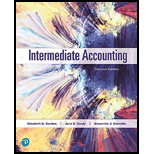
a.
To prepare: The journal entriesrecording of compensation expense over the vesting period.
Giveninformation:
Number of shares as an option is10,000.
Par value of common stock is $2.
Exercise price per share is $18.
Vesting time period is 2 years.
Estimated fair value at the grant date is $250,000
Initial vesting probability is 100%.
b.
To prepare: The journal entries for recording of compensation expense over the vesting period.
Given information:
Number of shares as an option is 10,000.
Par value of common stock is $2.
Exercise price per share is $18.
Vesting time period is 2 years.
Estimated fair value at the grant date is $250,000
Initial vesting probability of year 1 is 100%.
Vesting probability of year 2 is 60%.
c.
The recording of expiration of all options and journal entries related to it.
Given information:
Number of shares as an option is 10,000
Par value of common stock is $2.
Exercise price per share is $18.
Vesting time period is 2 years.
Estimated fair value at the grant date is $250,000
Initial vesting probability of year 1 is 100%.
Vesting probability of year 2 is 60%.
d.
The recording of compensation expense over the vesting period and journal entries.
Given information:
Number of shares as an option is 10,000.
Par value of common stock is $2.
Exercise price per share is $18.
Vesting time period is 2 years.
Estimated fair value at the grant date is $250,000
Initial vesting probability of year 1 is 80%.
Vesting probability of year 2 is 80%.
Want to see the full answer?
Check out a sample textbook solution
Chapter 19 Solutions
Intermediate Accounting (2nd Edition)
- Jbl company problem sopve it.arrow_forwardHow much intrest bank collect?arrow_forwardRequired information Skip to question [The following information applies to the questions displayed below.]XYZ declared a $1 per share dividend on August 15. The date of record for the dividend was September 1 (the stock began selling ex-dividend on September 2). The dividend was paid on September 10. Ellis is a cash-method taxpayer. Determine if he must include the dividends in gross income under the following independent circumstances. b. Ellis bought 100 shares of XYZ stock on August 1 for $21 per share. Ellis sold his XYZ shares on September 5 for $23 per share. Ellis received the $100 dividend on September 10 (note that even though Ellis didn’t own the stock on September 10, he still received the dividend because he was the shareholder on the record date).arrow_forward

 AccountingAccountingISBN:9781337272094Author:WARREN, Carl S., Reeve, James M., Duchac, Jonathan E.Publisher:Cengage Learning,
AccountingAccountingISBN:9781337272094Author:WARREN, Carl S., Reeve, James M., Duchac, Jonathan E.Publisher:Cengage Learning, Accounting Information SystemsAccountingISBN:9781337619202Author:Hall, James A.Publisher:Cengage Learning,
Accounting Information SystemsAccountingISBN:9781337619202Author:Hall, James A.Publisher:Cengage Learning, Horngren's Cost Accounting: A Managerial Emphasis...AccountingISBN:9780134475585Author:Srikant M. Datar, Madhav V. RajanPublisher:PEARSON
Horngren's Cost Accounting: A Managerial Emphasis...AccountingISBN:9780134475585Author:Srikant M. Datar, Madhav V. RajanPublisher:PEARSON Intermediate AccountingAccountingISBN:9781259722660Author:J. David Spiceland, Mark W. Nelson, Wayne M ThomasPublisher:McGraw-Hill Education
Intermediate AccountingAccountingISBN:9781259722660Author:J. David Spiceland, Mark W. Nelson, Wayne M ThomasPublisher:McGraw-Hill Education Financial and Managerial AccountingAccountingISBN:9781259726705Author:John J Wild, Ken W. Shaw, Barbara Chiappetta Fundamental Accounting PrinciplesPublisher:McGraw-Hill Education
Financial and Managerial AccountingAccountingISBN:9781259726705Author:John J Wild, Ken W. Shaw, Barbara Chiappetta Fundamental Accounting PrinciplesPublisher:McGraw-Hill Education





